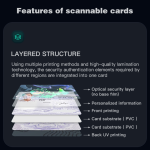In 2025, the landscape of identification documents has evolved, and being able to distinguish between real and fake IDs is of utmost importance. Whether you are a business owner checking IDs at the entrance of a bar or club, a law – enforcement officer on patrol, or simply someone who wants to avoid unknowingly dealing with a forged document, understanding the key differences is crucial.
### Physical Appearance
One of the first aspects to consider is the physical appearance of the ID.
#### Material
– **Real ID**: In 2025, real identification cards are typically made from high – quality materials. Most driver’s licenses and state – issued IDs are crafted from a durable plastic that has a smooth texture but also a certain level of thickness. For example, the plastic is often of a type that can withstand normal wear and tear, such as being in a wallet or pocket for long periods. It may also have a slight flex to it, but not so much that it feels flimsy.
– **Fake ID**: Fake IDs, on the other hand, may be made from cheaper materials. Some may be too thin, feeling more like a piece of paper with a plastic coating. Others might be made from a brittle plastic that could crack easily if bent slightly. The lower – quality material is often a giveaway as it doesn’t match the standards set for official government – issued documents.
#### Printing Quality
– **Real ID**: The printing on a real ID is of high resolution. The text is sharp, with consistent font styles and sizes. Photos are clear, with natural skin tones and no pixelation. Additionally, there are often micro – printing features that are difficult to replicate. For instance, tiny text might be printed around the edges of the ID or within certain design elements. This micro – printing can only be seen with a magnifying glass and contains important information like the issuing agency’s name or the cardholder’s details in a very small font.
– **Fake ID**: Fake IDs usually have lower – quality printing. The text may be blurry or have uneven edges. Photos can look pixelated or have an unnatural color tone. Micro – printing is extremely difficult to replicate accurately, and in most cases, fake IDs either lack this feature entirely or have a poor imitation of it.
### Security Features
Security features are some of the most important elements in differentiating between real and fake IDs.
#### Holograms
– **Real ID**: In 2025, real IDs often have advanced holographic elements. These holograms can be multi – layered and change appearance when viewed from different angles. For example, a state ID might have a hologram of the state’s emblem that appears to move and change color as the card is tilted. Some holograms also have embedded text or numbers that are only visible under certain lighting conditions or at specific viewing angles.
– **Fake ID**: Fake holograms are usually of a lower quality. They may be flat and lack the depth and movement of real holograms. The colors might be duller, and the details may not be as sharp. In some cases, the hologram may be a simple sticker that can be easily peeled off, rather than being an integral part of the ID as in the case of real documents.
#### UV – Responsive Elements
– **Real ID**: Many real IDs now have UV – responsive features. When exposed to ultraviolet light, certain parts of the ID will glow or reveal hidden information. This could be in the form of a UV – reactive ink used for printing text, a logo, or a specific design element. For example, the state seal on a driver’s license might glow a certain color under UV light, or there could be a hidden serial number that becomes visible.
– **Fake ID**: Fake IDs may either not have any UV – responsive elements at all or have poor imitations. The glow, if present, may not be the correct color or intensity as that of a real ID. The hidden information, if any, may be inaccurate or not in the proper location as per the real document’s design.
#### Magnetic Stripe or Chip
– **Real ID**: Real identification cards often come with a magnetic stripe or a microchip. The magnetic stripe contains encoded information such as the cardholder’s name, address, and license number. In the case of a chip – enabled ID, it can store even more detailed information and can be used for secure authentication in some systems. For example, at some border control points, the chip in a real ID can be read to quickly verify the identity of the traveler.
– **Fake ID**: Fake IDs may have a non – functional magnetic stripe or a chip that doesn’t contain accurate or any information at all. The stripe might be a simple sticker – like layer that has no real encoding, or the chip could be a dummy component just for the sake of appearance.
### Information and Formatting
The information presented on the ID and its formatting can also provide clues.
#### Personal Information
– **Real ID**: The personal information on a real ID is accurate and consistent. The name, date of birth, and address should match official records. The font and spacing of the text are uniform, and there are no spelling or grammar errors. For example, the name should be in the correct case (first name capitalized, last name capitalized), and the date of birth should be in a standard format.
– **Fake ID**: Fake IDs may have incorrect or inconsistent personal information. There could be spelling mistakes in the name, or the date of birth might not follow the proper format. Sometimes, the address might be a made – up or non – existent location. Additionally, the font and spacing may vary, giving an overall unprofessional look.
#### Formatting
– **Real ID**: Real IDs follow a specific format set by the issuing agency. There are standard locations for different elements such as the photo, name, and identification number. The layout is designed to be both aesthetically pleasing and functional. For example, on a driver’s license, the photo is usually in a specific corner, and the license number is in a pre – defined location.
– **Fake ID**: Fake IDs may deviate from the standard format. The placement of elements might be off, or the overall layout might look haphazard. This could be due to the forger not having accurate information about the correct design or being unable to replicate it precisely.
### Common Problems and Solutions
#### Problem 1: Difficulty in Identifying Micro – Printing
– **Description**: Some people may have trouble seeing or recognizing micro – printing on an ID, especially if they don’t have the right tools.
– **Solution**: Invest in a small magnifying glass that can be easily carried around. A magnifying glass with at least 10x magnification can make it much easier to spot micro – printing. Practice using the magnifying glass on known real IDs to get familiar with what the micro – printing looks like.
#### Problem 2: Uncertainty about Hologram Quality
– **Description**: It can be hard to tell if a hologram is real or fake, especially when the differences are subtle.
– **Solution**: Familiarize yourself with the holographic features of real IDs from the specific issuing state or country. Look at sample real IDs and study how the holograms change appearance under different lighting conditions and viewing angles. Compare the hologram on the ID in question with these known real – ID holograms.
#### Problem 3: Inability to Check UV – Responsive Elements
– **Description**: Not everyone has access to a UV light source to check for UV – responsive features on an ID.
– **Solution**: Consider purchasing a small, portable UV flashlight. These are relatively inexpensive and can be a valuable tool for ID verification. If you don’t have a UV light immediately available, ask the person presenting the ID to wait while you obtain one from a nearby location, such as a security office or a storage area where one might be kept.
#### Problem 4: Doubts about Magnetic Stripe or Chip Functionality
– **Description**: Without the proper equipment, it’s difficult to determine if the magnetic stripe or chip on an ID is functional.
– **Solution**: In a business setting, consider investing in a basic card – reading device that can quickly check the magnetic stripe for encoded information. For chip – enabled IDs, some more advanced card readers can be used. If you don’t have access to such equipment, look for other signs of authenticity first, such as physical appearance and security features. You can also contact the relevant issuing agency for assistance in verifying the ID if you have strong doubts.
#### Problem 5: Inconsistent Personal Information Checks
– **Description**: Verifying personal information on an ID against official records can be a challenge, especially if you don’t have access to a comprehensive database.
– **Solution**: In a business context, you can ask for additional forms of identification that may have the same personal information, such as a credit card or a utility bill. Cross – reference the information on these documents with the ID. If you are a law – enforcement officer, use the resources available through your department, such as law – enforcement databases, to check the accuracy of the personal information on the ID.
Fake ID Pricing
unit price: $109
| Order Quantity | Price Per Card |
|---|---|
| 2-3 | $89 |
| 4-9 | $69 |
| 10+ | $66 |


